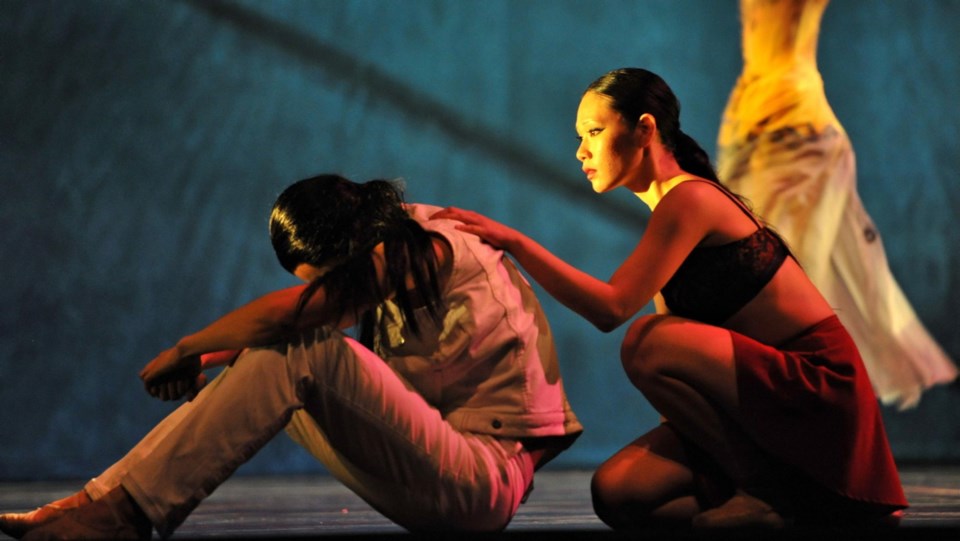What: Going Home Star — Truth and Reconciliation
Where: Royal Theatre
When: Saturday, Sunday
Rating: 3 stars (out of 5)
Going Home Star — Truth and Reconciliation is an empathetic, well-intentioned ballet that wears its heart on its sleeve.
Although this brave Royal Winnipeg Ballet extravaganza is beautifully danced, as a work of art it does slip at times (especially in the problematic second half). But it is sincere, well meant and often interesting.
Choreographed by Mark Godden, this full-length ballet has a history crucial to understanding it. Going Home Star is intended as an artistic respond to Canada’s Truth and Reconciliation Commission, which investigated horrendous abuses at residential schools for First Nations Children. It’s important to know the dance was championed by two forward-thinking aboriginal women: Mary Richard and Tina Keeper.
On Friday at the Royal Theatre, we knew it was going to be a singular evening when an affable crew of First Nations drummers opened the show. Before that, RWB artistic director Andre Lewis advised us counselors would be available for those disturbed by the content (the ballet includes fleeting scenes of children being beaten and sexually abused). At intermission, indigenous elders performed cedar bough ceremonies on volunteer audience members.
Going Home Star is about a young First Nations hairdresser, Annie (well danced this night by Sophia Lee). She lives a party-girl lifestyle in the big city; we see her dancing at clubs and snorting coke.
Annie meets a jean-jacketed aboriginal trickster called Gordon (danced with regal bearing by Liang Xing). Gordon revives a prone Annie, Sleeping Beauty-style, with a kiss. He then educates Annie on her heritage through a series of flashbacks revealing the abuses he and others endured at residential schools.
The first half of Going Home Star, following a narrative form, is the most successful. Composer Christos Hatzis’s score melds, sometimes successfully, a pastiche of styles. Often orchestral, it’s sometimes reminiscent of Tchaikovsky, Leonard Bernstein and Aaron Copeland. Musical quotes (Swan Lake, Moon River) are tossed in.
Elsewhere, we hear a sort of primal thrum, a cosmic moaning, courtesy of Steve Wood and the Northern Cree Singers and throat singer Tanya Tagaq. This contrasts dramatically with the score’s European elements.
The dance vocabulary is based on classical ballet, with vivacious contemporary touches. One scene, danced in street costumes, recalls the youthful vivacity of West Side Story.
Going Home Star radiates a vitality and freshness that stems from seeing an important social issue brought to life via dance. This is our story, Going Home Star proclaims. It is an important story, a Canadian story (the ballet’s story-line, by the way, was created by Canadian novelist Joseph Boyden, who attended Friday’s performance).
The second act of the two-hour ballet is equally well intentioned, but works rather less well. The biggest problem is that Going Home Star ultimately lapses into the sort of literalism that diminishes the power and profundity of any artwork.
This had occurred somewhat in Act I, for example, when Gordon placed a model of a residential school on his shoulders, then collapsed repeatedly under the burden. This, presumably, indicates generations of abuse.
In Act II, we saw clerics wearing black, semi-transparent robes that had a Star-Trek/fetish club vibe. A stained-glass-style pod, green and amber, (the church?) was lowered from the ceiling.
And then a group of male and female dancers appeared with glittering headdresses in the shape of sailing ships. They cavorted, with deliberate awkwardness, to baroque/classical-style music. The hammer-headed symbolism: we were witnessing the influx of Europeans to North America.
When it comes to visual metaphor, sailboat hats are never a particularly good idea. (In my notebook I wrote: “Jumping the shark?”) Meanwhile, a voice-over explained how First Nations people took care of white settlers, showing them how to obtain moose, fish and beavers. In return, we were told, the aboriginal children were forced from their families into residential school where they were beaten, sexually abused and compelled to speak a foreign language.
“It’s OK to remember, it’s OK to forget,” repeated the voice-over.
The Royal Winnipeg Ballet deserves credit for boldly tackling a hot-button social issue, something few companies would even consider. The RWB can only be praised for its integrity and thoughtful daring. And to its credit, Going Home Star is not as didactic or preachy as it could have been.
My thoughts on leaving the theatre were this: we are a young country, both historically and artistically. The journey has only just begun.



